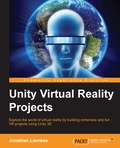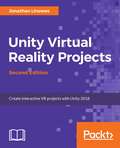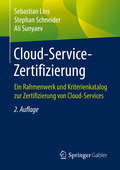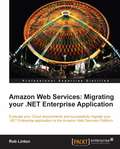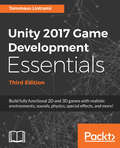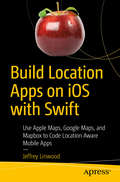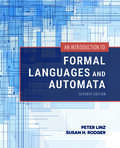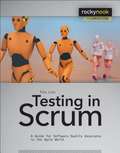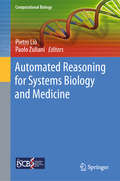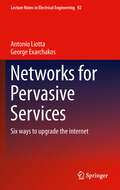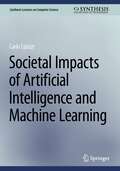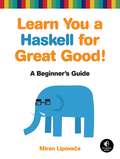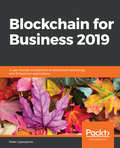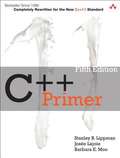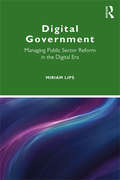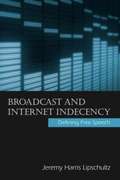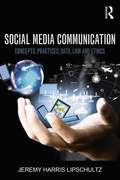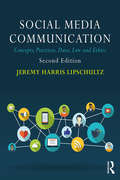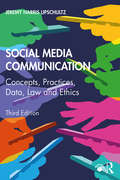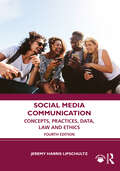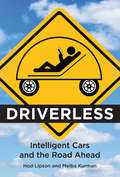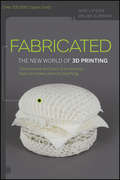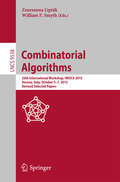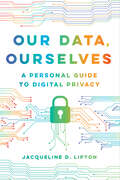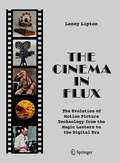- Table View
- List View
Unity Virtual Reality Projects
by Jonathan LinowesExplore the world of Virtual Reality by building immersive and fun VR projects using Unity 3D About This Book * Learn the basic principles of virtual reality applications and get to know how they differ from games and desktop apps * Build various types of VR experiences, including diorama, first-person characters, riding on rails, 360 degree projections, and social VR * A project-based guide that teaches you to use Unity to develop VR applications, which can be experienced with devices such as the Oculus Rift or Google Cardboard Who This Book Is For If you're a non-programmer unfamiliar with 3D computer graphics, or experienced in both but new to virtual reality, and are interested in building your own VR games or applications then this book is for you. Any experience in Unity is an advantage. What You Will Learn * Create 3D scenes with Unity and Blender while learning about world space and scale * Build and run VR applications for consumer headsets including Oculus Rift and Google Cardboard * Build interactive environments with physics, gravity, animations, and lighting using the Unity engine * Experiment with various user interface (UI) techniques that you can use in your VR applications * Implement the first-person and third-person experiences that use only head motion gestures for input * Create animated walkthroughs, use 360-degree media, and build multi-user social VR experiences * Learn about the technology and psychology of VR including rendering, performance and VR motion sickness * Gain introductory and advanced experience in Unity programming with the C# language In Detail What is consumer "virtual reality"? Wearing a head-mounted display you view stereoscopic 3D scenes. You can look around by moving your head, and walk around using hand controls or motion sensors. You are engaged in a fully immersive experience. On the other hand, Unity is a powerful game development engine that provides a rich set of features such as visual lighting, materials, physics, audio, special effects, and animation for creating 2D and 3D games. Unity 5 has become the leading platform for building virtual reality games, applications and experiences for this new generation of consumer VR devices. Using a practical and project-based approach, this book will educate you about the specifics of virtual reality development in Unity. You will learn how to use Unity to develop VR applications which can be experienced with devices such as the Oculus Rift or Google Cardboard. We will then learn how to engage with virtual worlds from a third person and first person character point of view. Furthermore, you will explore the technical considerations especially important and possibly unique to VR. The projects in the book will demonstrate how to build a variety of VR experiences. You will be diving into the Unity 3D game engine via the interactive Unity Editor as well as C-Sharp programming. By the end of the book, you will be equipped to develop rich, interactive virtual reality experiences using Unity. So, let's get to it! Style and approach This book takes a practical, project-based approach to teach specifics of virtual reality development in Unity. Using a reader-friendly approach, this book will not only provide detailed step-by-step instructions but also discuss the broader context and applications covered within.
Unity Virtual Reality Projects: Learn Virtual Reality by developing more than 10 engaging projects with Unity 2018, 2nd Edition
by Jonathan LinowesExplore the latest features of Unity 2018 to create immersive VR projects for Oculus Rift, HTC Vive, Daydream and Gear VRKey FeaturesA project-based guide to teach you how to develop immersive and fun VR applications using Unity 3DBuild experiences with interactable objects, physics, UI, animations, C# scripting, and other Unity featuresExplore the world of VR by building experiences such as diorama, first-person characters, 360-degree projections, social VR, audio fireball game, and VR storytelling Book DescriptionUnity has become the leading platform for building virtual reality games, applications, and experiences for this new generation of consumer VR devices. Unity Virtual Reality Projects walks you through a series of hands-on tutorials and in-depth discussions on using the Unity game engine to develop VR applications. With its practical and project-based approach, this book will get you up to speed with the specifics of VR development in Unity. You will learn how to use Unity to develop VR applications that can be experienced with devices such as Oculus, Daydream, and Vive. Among the many topics and projects, you will explore gaze-based versus hand-controller input, world space UI canvases, locomotion and teleportation, software design patterns, 360-degree media, timeline animation, and multiplayer networking. You will learn about the Unity 3D game engine via the interactive Unity Editor, and you will also learn about C# programming. By the end of the book, you will be fully equipped to develop rich, interactive VR experiences using Unity.What you will learnCreate 3D scenes with Unity and other 3D tools while learning about world space and scaleBuild and run VR applications for specific headsets, including Oculus, Vive, and DaydreamInteract with virtual objects using eye gaze, hand controllers, and user input eventsMove around your VR scenes using locomotion and teleportationImplement an audio fireball game using physics and particle systemsImplement an art gallery tour with teleportation and data infoDesign and build a VR storytelling animation with a soundtrack and timelinesCreate social VR experiences with Unity networkingWho this book is forIf you're a non-programmer unfamiliar with 3D computer graphics, or experienced in both but new to virtual reality, and are interested in building your own VR games or applications, then this book is for you. Any experience in Unity is an advantage.
Cloud-Service-Zertifizierung: Ein Rahmenwerk und Kriterienkatalog zur Zertifizierung von Cloud-Services
by Sebastian Lins Stephan Schneider Ali SunyaevDieses Buch liefert ein Rahmenwerk zur Zertifizierung von Services in der Cloud. Herzstück dabei ist ein umfangreicher Kriterienkatalog zum Assessment von Cloud-Services, der im Forschungsprojekt „Value4Cloud“ , gefördert vom Bundesministerium für Wirtschaft und Technologie, entwickelt wurde. Cloud-Service-Anwender werden bei der Bewertung, dem Vergleich und der Auswahl von Services unterstützt. Das Buch eignet sich auch für Cloud-Service-Anbieter zum Self-Assessment und zur Verbesserung der eigenen Services.
Amazon Web Services: Migrating your .NET Enterprise Application
by Rob LintonThis practical, step-by-step guide follows the process of moving a sample Enterprise .NET application to the Amazon Cloud.Companies that have designed, developed, and hosted applications based on the Microsoft .NET technology stack should not miss out on this book. If you are looking to expand into using the vast array of services available on the Amazon Cloud but are unsure how to proceed, then this will help to get you on your way.Administrators or developers managing such applications should have basic experience of the platform and the web servers that thay are intending to move to Amazon. No knowledge of AWS is required.
Unity 2017 Game Development Essentials, Third Edition: Build fully functional 2D and 3D games with realistic environments, sounds, physics, special effects, and more!
by Tommaso Lintrami Will GoldstoneGo through 3D game development techniques using Unity Key Features Kick-start your game development carrer and build ready-to-play 2D and 3D games with ease Understand the key concepts in game design including scripting, physics, instantiation, particle effects, and more Build games that run on desktop, mobile, and the web Book Description Unity is the most popular game engine among Indie developers, start-ups, and medium to large independent game development companies. This book is a complete exercise in game development covering environments, physics, sound, particles, and much more—to get you up and running with Unity rapidly. In this informal guide, you’ll get to grips with the basics of game development, starting off with using C# for scripting. You'll get the hang of Unity's development environment and will be able to set up the required assets for your frst 2D game. You'll work on animating your player and getting it to move in the 2D environment. Next, you'll see how to build the game in 3D, making use of Unity's new 3D animation system. After building a beautiful 3D environment for the game, you’ll work with the latest physics system that Unity has to offer and will make your assets interactive. You'll induce artifcial intelligence into the enemies and develop a mechanism to hit them with rocks and punches. Once you've made things pretty with the particle system, you'll move on to optimize the game, adding a cross-platform ready UI, and publishing your game across multiple platforms. You'll walk away with a cool 2D parallax side parallax game and an even cooler third-person 3D adventure game, but most importantly, with the confdence to build your own games. What you will learn Script games using C# Build your very first 2D and 3D games Work through the key concepts in game development such as animations, physics, and scripting Test and optimize your games to attain great performance Create fully functional menus, HUDs, and UI Create player character interactions with AI and NPC Who this book is for Who this book is written for: If you're a designer or animator who wishes to take their first steps into game development or prototyping, or if you've simply spent many hours sitting in front of video games with ideas bubbling away in the back of your mind, Unity and this book should be your starting point.
Build Location Apps on iOS with Swift: Use Apple Maps, Google Maps, and Mapbox to Code Location Aware Mobile Apps
by Jeffrey LinwoodWork with Apple Maps, Google Maps, and Mapbox in iOS with Swift programming. Guided by practical examples, this book covers all three map frameworks to ensure you properly select which one best suits your iOS app's needs in working with iOS location.You'll see how Apple's privacy settings apply to a user's location, and how to access that user's location from an application. Once you have access to the user's location, allow your app to display points of interest from Apple's database on the map inside the app, as well as to provide a search through that database by name. You can also incorporate turn by turn directions inside your own app to provide routes. Or trigger different functionality or notifications based on locational queues. With Build Location Apps on iOS with Swift, you'll even find out how to provide offline map support for hiking, camping, or other outdoors applications where cell phone service is weak.What You'll LearnDisplay points of interest within your own appWork with Apple's privacy settings so pertinent information comes throughTrigger functionality based on geographic promptsCreate your own custom map styles with Mapbox Studio and display them in the appWho This Book Is ForIntermediate to advanced Swift programmers who would like to add location based services to their apps.
An Introduction to Formal Languages and Automata
by Peter Linz Susan H. RodgerAn Introduction to Formal Languages and Automata, Seventh Edition is designed for an introductory course on formal languages, automata, compatibility, and related matters forming what is known as the theory of computation.
Testing in Scrum
by Tilo LinzThese days, more and more software development projects are being carried out using agile methods like Scrum. Agile software development promises higher software quality, a shorter time to market, and improved focus on customer needs. However, the transition to working within an agile methodology is not easy. Familiar processes and procedures change drastically. Software testing and software quality assurance have a crucial role in ensuring that a software development team, department, or company successfully implements long-term agile development methods and benefits from this framework. This book discusses agile methodology from the perspective of software testing and software quality assurance management. Software development managers, project managers, and quality assurance managers will obtain tips and tricks on how to organize testing and assure quality so that agile projects maintain their impact. Professional certified testers and software quality assurance experts will learn how to work successfully within agile software teams and how best to integrate their expertise. Topics include:Agile methodology and classic process models How to plan an agile project Unit tests and test first approach Integration testing and continuous integration System testing and test nonstop Quality management and quality assurance Also included are five case studies from the manufacturing, online-trade, and software industry as well as test exercises for self-assessment. This book covers the new ISTQB Syllabus for Agile Software Testing and is a relevant resource for all students and trainees worldwide who plan to undertake this ISTQB certification.
Automated Reasoning for Systems Biology and Medicine (Computational Biology #30)
by Pietro Liò Paolo ZulianiThis book presents outstanding contributions in an exciting, new and multidisciplinary research area: the application of formal, automated reasoning techniques to analyse complex models in systems biology and systems medicine. Automated reasoning is a field of computer science devoted to the development of algorithms that yield trustworthy answers, providing a basis of sound logical reasoning. For example, in the semiconductor industry formal verification is instrumental to ensuring that chip designs are free of defects (or “bugs”). Over the past 15 years, systems biology and systems medicine have been introduced in an attempt to understand the enormous complexity of life from a computational point of view. This has generated a wealth of new knowledge in the form of computational models, whose staggering complexity makes manual analysis methods infeasible. Sound, trusted, and automated means of analysing the models are thus required in order to be able to trust their conclusions. Above all, this is crucial to engineering safe biomedical devices and to reducing our reliance on wet-lab experiments and clinical trials, which will in turn produce lower economic and societal costs. Some examples of the questions addressed here include: Can we automatically adjust medications for patients with multiple chronic conditions? Can we verify that an artificial pancreas system delivers insulin in a way that ensures Type 1 diabetic patients never suffer from hyperglycaemia or hypoglycaemia? And lastly, can we predict what kind of mutations a cancer cell is likely to undergo? This book brings together leading researchers from a number of highly interdisciplinary areas, including: · Parameter inference from time series · Model selection · Network structure identification · Machine learning · Systems medicine · Hypothesis generation from experimental data · Systems biology, systems medicine, and digital pathology · Verification of biomedical devices “This book presents a comprehensive spectrum of model-focused analysis techniques for biological systems ...an essential resource for tracking the developments of a fast moving field that promises to revolutionize biology and medicine by the automated analysis of models and data.”Prof Luca Cardelli FRS, University of Oxford
Networks for Pervasive Services
by Antonio Liotta George ExarchakosReaders will progress from an understanding of what the Internet is now towards an understanding of the motivations and techniques that will drive its future.
Societal Impacts of Artificial Intelligence and Machine Learning (Synthesis Lectures on Computer Science)
by Carlo LipizziThis book goes beyond the current hype of expectations generated by the news on artificial intelligence and machine learning by analyzing realistic expectations for society, its limitations, and possible future scenarios for the use of this technology in our current society. Artificial Intelligence is one of the top topics today and is inflating expectations beyond what the technology can do in the foreseeable future. The future cannot be predicted, but the future of some elements of our society, such as technology, can be estimated. This book merges the modeling of human reasoning with the power of AI technology allowing readers to make more informed decisions about their personal or financial decisions or just being more educated on current technologies. This book presents a model that sketches potential future scenarios based on a discussion of the expectations today, the analysis of the current gap in the literature, and a view of possible futures in terms of technology and use cases. Specifically, this book merges literature on the technology aspects, the sociological impacts, and philosophical aspects.
Learn You a Haskell for Great Good!: A Beginner's Guide (No Starch Press Ser.)
by Miran Lipovaca<P>It's all in the name: Learn You a Haskell for Great Good! is a hilarious, illustrated guide to this complex functional language. Packed with the author's original artwork, pop culture references, and most importantly, useful example code, this book teaches functional fundamentals in a way you never thought possible. <P>You'll start with the kid stuff: basic syntax, recursion, types and type classes. Then once you've got the basics down, the real black belt master-class begins: you'll learn to use applicative functors, monads, zippers, and all the other mythical Haskell constructs you've only read about in storybooks. <P>As you work your way through the author's imaginative (and occasionally insane) examples, you'll learn to: <br>–Laugh in the face of side effects as you wield purely functional programming techniques <br>–Use the magic of Haskell's "laziness" to play with infinite sets of data <br>–Organize your programs by creating your own types, type classes, and modules <br>–Use Haskell's elegant input/output system to share the genius of your programs with the outside world <P>Short of eating the author's brain, you will not find a better way to learn this powerful language than reading Learn You a Haskell for Great Good!
Blockchain for Business 2019: A user-friendly introduction to blockchain technology and its business applications
by Peter LipovyanovYour one-stop guide to blockchain technology and its business applications Key Features Assimilate blockchain services such as Ethereum and Hyperledger to transform industrial applications Know in and out of blockchain technology to understand various business use cases Understand various common and not-so-common challenges faced in blockchain development Book Description Blockchain for Business 2019 is a comprehensive guide that enables you to bring in various blockchain functionalities to extend your existing business models and make correct fully-informed decisions. You will learn how decentralized applications are transforming numerous business sectors that are expected to play a huge role in the future. You will see how large corporations are already implementing blockchain technology now. You will then learn about the various blockchain services, such as Bitcoin, Ethereum, Hyperledger, and others to understand their use cases in a variety of business domains. You will develop a solid fundamental understanding of blockchain architecture. Moving ahead, you will get to grips with the inner workings of blockchain, with detailed explanations of mining, decentralized consensus, cryptography, smart contracts, and many other important concepts. You will delve into a realistic view of the current state of blockchain technology, along with its issues, limitations, and potential solutions that can take it to the next level. By the end of this book, you will all be well versed in the latest innovations and developments in the emerging blockchain space. What you will learn Understand the fundamentals of blockchain and how it was developed Gain a good understanding of economic concepts and developments Develop a base for concepts such as cryptography, computer networking, and programming Understand the applications of blockchain and its potential impact on the world Become well versed with the latest developments in the blockchain space Explore blockchain frameworks, including decentralized organizational structures, networks, and applications Who this book is for This book is for financial professionals, business executives, managers, and enthusiasts who are interested in getting well-versed with blockchain technology in various business domains. This book will help boost your existing business models using blockchain services. No prior experience of blockchain is required.
C++ Primer
by Stanley B. Lippman Josée Lajoie Barbara E. MooFully updated and recast for the newly released C++11 standard, this authoritative and comprehensive introduction to C++ will help you to learn the language fast, and to use it in modern, highly effective ways. Highlighting today’s best practices, the authors show how to use both the core language and its standard library to write efficient, readable, and powerful code. C++ Primer, Fifth Edition, introduces the C++ standard library from the outset, drawing on its common functions and facilities to help you write useful programs without first having to master every language detail. The book’s many examples have been revised to use the new language features and demonstrate how to make the best use of them. This book is a proven tutorial for those new to C++, an authoritative discussion of core C++ concepts and techniques, and a valuable resource for experienced programmers, especially those eager to see C++11 enhancements illuminated. Start Fast and Achieve More Learn how to use the new C++11 language features and the standard library to build robust programs quickly, and get comfortable with high-level programming Learn through examples that illuminate today’s best coding styles and program design techniques Understand the “rationale behind the rules”: why C++11 works as it does Use the extensive crossreferences to help you connect related concepts and insights Benefit from up-to-date learning aids and exercises that emphasize key points, help you to avoid pitfalls, promote good practices, and reinforce what you’ve learned
Digital Government: Managing Public Sector Reform in the Digital Era (Routledge Masters in Public Management)
by Miriam LipsDigital Government: Managing Public Sector Reform in the Digital Era presents a public management perspective on digital government and technology-enabled change in the public sector. It incorporates theoretical and empirical insights to provide students with a broader and deeper understanding of the complex and multidisciplinary nature of digital government initiatives, impacts and implications. The rise of digital government and its increasingly integral role in many government processes and activities, including overseeing fundamental changes at various levels across government, means that it is no longer perceived as just a technology issue. In this book Miriam Lips provides students with practical approaches and perspectives to better understand digital government. The text also explores emerging issues and barriers as well as strategies to more effectively manage digital government and technology-enabled change in the public sector. Digital Government is the ideal book for postgraduate students on courses in public administration, public management, public policy, political science and international relations, and e-government. It is also suitable for public service managers who are experiencing the impact of digital technology and data in the public sector.
Broadcast and Internet Indecency: Defining Free Speech
by Jeremy Harris LipschultzThis book explores broadcast and Internet indecency from social and legal perspectives, using current cases and examples. Case law is used as a starting point from which to explore the social and legal boundaries of speech.
Social Media Communication: Concepts, Practices, Data, Law and Ethics
by Jeremy Harris LipschultzIn Social Media Communication: Concepts, Practices, Data, Law and Ethics, Jeremy Harris Lipschultz presents a wide-scale, interdisciplinary analysis and guide to social media. Examining platforms such as Twitter, Facebook, LinkedIn, Pinterest, Youtube and Vine, the book explores and analyzes journalism, broadcasting, public relations, advertising and marketing. Lipschultz focuses on key concepts, best practices, data analyses, law and ethics--all promoting the critical thinking professionals and students need to use new networking tools effectively and to navigate social and mobile media spaces. Featuring contemporary case studies, essays from some of the industry's leading social media innovators, and a comprehensive glossary, this practical, multipurpose textbook gives readers the resources they'll need to both evaluate and utilize current and future forms of social media. For more information about the book, supplementary updates and teaching materials, follow Social Media Communication online at: Facebook: https://www.facebook.com/SocialMediaCommunication Twitter: @JeremyHL #smc2015 SlideShare: http://www.slideshare.net/jeremylipschultz
Social Media Communication: Concepts, Practices, Data, Law and Ethics
by Jeremy Harris LipschultzIn the second edition of Social Media Communication: Concepts, Practices, Data, Law and Ethics, Jeremy Harris Lipschultz presents a wide-scale, interdisciplinary analysis and guide to social media. Examining platforms such as Facebook, Instagram, Snapchat, LinkedIn, YouTube and Pinterest, this book explores and analyzes journalism, broadcasting, public relations, advertising and marketing. Lipschultz focuses on key concepts, best practices, data analyses, law and ethics—all promoting the critical thinking professionals and students need to use new networking tools effectively and to navigate social and mobile media spaces. Featuring historical markers and contemporary case studies, essays from some of the industry’s leading social media innovators and a comprehensive glossary, this practical, multipurpose textbook gives readers the resources they’ll need to both evaluate and utilize current and future forms of social media. For more information about the book, supplementary updates and teaching materials, follow the Social Media Communication Facebook page, @JeremyHL on Twitter and the UNO Social Media Lab on SlideShare. Facebook: www.facebook.com/SocialMediaCommunication Twitter: @JeremyHL #UNOSML #SMC2018 #SMProfs SlideShare: www.slideshare.net/jeremylipschultz
Social Media Communication: Concepts, Practices, Data, Law and Ethics
by Jeremy Harris LipschultzThis updated third edition presents a wide-scale, interdisciplinary guide to social media. Examining platforms like Facebook, Instagram, LinkedIn, Snapchat, TikTok, Twitter and YouTube, the book analyzes social media's use in journalism, broadcasting, public relations, advertising and marketing. Lipschultz focuses on key concepts, best practices, data analyses, law and ethics – all promoting the critical thinking that is needed to use new, evolving and maturing networking tools effectively within social and mobile media spaces. Featuring historical markers and contemporary case studies, essays from some of the industry’s leading social media innovators and a comprehensive glossary, this practical, multipurpose textbook gives readers the resources they will need to both evaluate and utilize current and future forms of social media communication. Among other changes, updates to the third edition include a deep dive into new approaches to analytics, as well as greater discussion of law and ethics in light of the Facebook Cambridge Analytica scandal, the roll-out of GDPR and new case law relating to social media. Social Media Communication is the perfect social media primer for students and professionals, and, with a dedicated teaching guide, ideal for instructors, too.
Social Media Communication: Concepts, Practices, Data, Law and Ethics
by Jeremy Harris LipschultzThis updated fourth edition presents a wide-scale, interdisciplinary guide to social media communication. Examining platforms like Facebook, Instagram, Snapchat, TikTok, Twitter and YouTube, the book analyzes social media's use in journalism, public relations, advertising and marketing. Lipschultz focuses on key concepts, best practices, data analyses, law and ethics – all promoting the critical thinking that is needed to use new, evolving and maturing networking tools effectively within social and mobile media spaces. Featuring historical markers and contemporary case studies, essays from some of the industry’s leading social media innovators and a comprehensive glossary, this practical, multipurpose textbook gives readers the resources they will need to both evaluate and utilize current and future forms of social media communication. Updates to the fourth edition include expanded discussion of disinformation, the impact of artificial intelligence (AI), natural language chatbots, virtual and augmented reality technologies and the COVID-19 infodemic. Social Media Communication is the perfect social media primer for students and professionals and, with a dedicated online teaching guide, ideal for instructors, too.
Driverless: Intelligent Cars and the Road Ahead
by Hod Lipson Melba KurmanWhen human drivers let intelligent software take the wheel: the beginning of a new era in personal mobility. Google's newest driverless car had no steering wheel and no brakes. The message was clear: cars of the future will be born fully autonomous, with no human driver needed. In the coming decade, self-driving cars will hit the streets, rearranging established industries and reshaping cities, giving us new choices in where we live and how we work and play.In this book, Hod Lipson and Melba Kurman offer readers insight into the risks and benefits of driverless cars and a lucid and engaging explanation of the enabling technology. Recent advances in software and robotics are toppling long-standing technological barriers that for decades have confined self-driving cars to the realm of fantasy. A new kind of artificial intelligence software called deep learning gives cars rapid and accurate visual perception. Human drivers can relax and take their eyes off the road. When human drivers let intelligent software take the wheel, driverless cars will offer billions of people all over the world a safer, cleaner, and more convenient mode of transportation. Although the technology is nearly ready, car companies and policy makers may not be. The authors make a compelling case for why government, industry, and consumers need to work together to make the development of driverless cars our society's next “Apollo moment.”
Fabricated
by Hod Lipson Melba KurmanFabricated tells the story of 3D printers, humble manufacturing machines that are bursting out of the factory and into schools, kitchens, hospitals, even onto the fashion catwalk. Fabricated describes our emerging world of printable products, where people design and 3D print their own creations as easily as they edit an online document.A 3D printer transforms digital information into a physical object by carrying out instructions from an electronic design file, or 'blueprint.' Guided by a design file, a 3D printer lays down layer after layer of a raw material to 'print' out an object. That's not the whole story, however. The magic happens when you plug a 3D printer into today's mind-boggling digital technologies. Add to that the Internet, tiny, low cost electronic circuitry, radical advances in materials science and biotech and voila! The result is an explosion of technological and social innovation.Fabricated takes the reader onto a rich and fulfilling journey that explores how 3D printing is poised to impact nearly every part of our lives.Aimed at people who enjoy books on business strategy, popular science and novel technology, Fabricated will provide readers with practical and imaginative insights to the question 'how will this technology change my life?' Based on hundreds of hours of research and dozens of interviews with experts from a broad range of industries, Fabricated offers readers an informative, engaging and fast-paced introduction to 3D printing now and in the future.
Combinatorial Algorithms: 26th International Workshop, IWOCA 2015, Verona, Italy, October 5-7, 2015, Revised Selected Papers (Lecture Notes in Computer Science #9538)
by Zsuzsanna Lipták William F. SmythThis book constitutes the thoroughly refereedpost-workshop proceedings for the 26 International Workshop on combinatorialAlgorithms, IWOCA 2015, held in Verona, Italy, in October 2015. The 29 revised full papers presented were carefullyreviewed and selected from a total of 90 submissions. The topics of the papersinclude algorithms and data structures (including sequential, parallel,distributed, approximation, probabilistic, randomised, and on-line algorithms),algorithms on strings and graphs; applications (bioinformatics, music analysis,networking, and others); combinatorics on words; combinatorial enumeration;combinatorial optimization; complexity theory; computational biology;compression and information retrieval; cryptography and information security;decompositions and combinatorial designs; discrete and computational geometry;graph drawing and labeling; graph theory.
Our Data, Ourselves: A Personal Guide to Digital Privacy
by Jacqueline D. LiptonA practical, user-friendly handbook for understanding and protecting our personal data and digital privacy. Our Data, Ourselves addresses a common and crucial question: What can we as private individuals do to protect our personal information in a digital world? In this practical handbook, legal expert Jacqueline D. Lipton guides readers through important issues involving technology, data collection, and digital privacy as they apply to our daily lives.Our Data, Ourselves covers a broad range of everyday privacy concerns with easily digestible, accessible overviews and real-world examples. Lipton explores the ways we can protect our personal data and monitor its use by corporations, the government, and others. She also explains our rights regarding sensitive personal data like health insurance records and credit scores, as well as what information retailers can legally gather, and how. Who actually owns our personal information? Can an employer legally access personal emails? What privacy rights do we have on social media? Answering these questions and more, Our Data, Ourselves provides a strategic approach to assuming control over, and ultimately protecting, our personal information.
The Cinema in Flux: The Evolution of Motion Picture Technology from the Magic Lantern to the Digital Era
by Lenny LiptonThe first of its kind, this book traces the evolution of motion picture technology in its entirety. Beginning with Huygens' magic lantern and ending in the current electronic era, it explains cinema’s scientific foundations and the development of parallel enabling technologies alongside the lives of the innovators. Product development issues, business and marketplace factors, the interaction of aesthetic and technological demands, and the patent system all play key roles in the tale. The topics are covered sequentially, with detailed discussion of the transition from the magic lantern to Edison’s invention of the 35mm camera, the development of the celluloid cinema, and the transition from celluloid to digital. Unique and essential reading from a lifetime innovator in the field of cinema technology, this engaging and well-illustrated book will appeal to anyone interested in the history and science of cinema, from movie buffs to academics and members of the motion picture industry.
